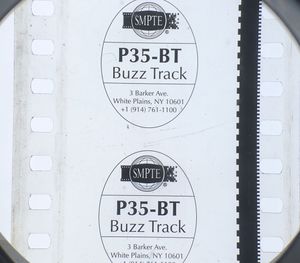| Welcome to Sprocket School! This project is maintained by volunteer editors. Learn more about how this works. |
Buzz Track: Difference between revisions
(Created page with "thumb|300px|35mm Buzz Track thumb|300px|16mm Buzz Track '''Buzz Track''' is a test film used to align the lateral posi...") |
JesseCrooks (talk | contribs) m (Linked to "Test Film" page) |
||
| Line 2: | Line 2: | ||
[[File:16mm Buzz Track.jpg|thumb|300px|16mm Buzz Track]] | [[File:16mm Buzz Track.jpg|thumb|300px|16mm Buzz Track]] | ||
'''Buzz Track''' is a test film used to align the lateral position of the film in relation to the optical sound pickup. | '''Buzz Track''' is a [[test film]] used to align the lateral position of the film in relation to the optical sound pickup. | ||
Two square frequencies are printed to the left and right of the optical track. The lateral guide roller is adjusted so that neither frequency is audible. '''Consult your equipment manual for instruction on this adjustment.''' The goal of this adjustment is to avoid picking up non soundtrack noise such as image, DTS timecode, or sprockets. | Two square frequencies are printed to the left and right of the optical track. The lateral guide roller is adjusted so that neither frequency is audible. '''Consult your equipment manual for instruction on this adjustment.''' The goal of this adjustment is to avoid picking up non soundtrack noise such as image, DTS timecode, or sprockets. | ||
Revision as of 13:29, 12 May 2020


Buzz Track is a test film used to align the lateral position of the film in relation to the optical sound pickup.
Two square frequencies are printed to the left and right of the optical track. The lateral guide roller is adjusted so that neither frequency is audible. Consult your equipment manual for instruction on this adjustment. The goal of this adjustment is to avoid picking up non soundtrack noise such as image, DTS timecode, or sprockets.
On some older mono pickups with wider slits, or when using a buzz track film that has shrunken slightly, it may be impossible to completely eliminate the buzz track frequencies. In this case, split the difference so that both frequencies are as quiet as possible.
Although this adjustment can be done by ear, it is helpful to be able to evaluate the results on an oscilloscope.
Buzz Track alignment can drift over time and should be checked on a regular basis.
Some batches of 35mm Buzz Track were misprinted with a frame line every four perforations. This can be used in the normal manner, though there is an audible thump 24 times per second.
As with all sound test films, a long loop or a 50-100' length of test film run reel to reel is very helpful. As a splice passes through, the film will take a moment to settle back in to place, making a very short or worn loop an imprecise and frustrating tool.